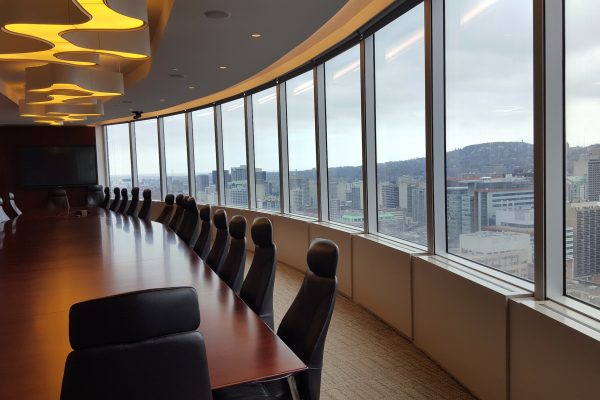COVID-19 has upended our economy, but not our class structure. The virus itself does not discriminate based on income, race, or ethnicity, but exposure and severity of infection skew heavily along those lines. Where we fall in the division of labor, the racial caste structure, and the distribution of wealth today quite literally determines our susceptibility to premature death.
Where we fall in the division of labor, the racial caste structure, and the distribution of wealth today quite literally determines our susceptibility to premature death.
Under social distancing orders, professionals have retreated to their homes, but low-wage workers continue to stock shelves, deliver food, and care for the sick, often without basic protective equipment. Tens of millions of others have lost their jobs, and many are now locked down with older and younger family members, or even amid crowds in cities. Maps released by New York City showed that wealthier areas of Manhattan had low rates of infection, while working-class and poor districts of Queens, Brooklyn, and the Bronx had the highest. Because working-class people and people of color are far more likely to suffer from overwork, lack of decent health care, and environmental exposure, they have higher rates of comorbidities, including diabetes, heart disease, and emphysema.
Things will get much worse before they get better. While Congress has finally passed paid sick leave, the legislation has many loopholes and will not cover workers at most large companies. That is one reason low-wage workers continue to work. Congress has also expanded unemployment benefits, but without further relief many families many will soon be unable to buy food. While some health insurers have promised to wave patients’ share of costs for COVID-19 treatment, many remain uninsured, and we will likely see a wave of bankruptcies.
In other words, the pandemic is highlighting the fragility of our labor markets just as much as the fragility of our public health and welfare systems. In the short term we’ll need to focus on providing health care, income support, and other needed goods and services to all. But as we take the economy out of its induced coma, we’ll also have to address more fundamental questions: What kinds of jobs do we want and need? What sorts of labor markets and other policies can deliver them? And at the most basic level, how do we want our state, society, and economy to relate to one another?
• • •
The crisis of work has been growing since the 1970s, and especially since the early 1980s. During that era of emergent neoliberalism, policymakers reorganized society around perceived market imperatives rather than ensuring that our economy serves the needs of the public. From intellectual property rights, to laws governing the movement of goods and capital across borders and the basic rules undergirding employment, governments have strengthened the hand of companies and other property holders, concentrating power and control over resources.
Labor markets have changed dramatically as a result. In the now familiar story, unionization declined across the global north, but plummeted in the United States. Meanwhile companies shunted as many workers as possible outside of their corporate boundaries through arrangements like subcontracting and franchising. As a result, they bear few legal duties toward many of the workers they depend upon, even if they monitor them closely through novel information technologies. Where once employment was a “social institution” governed both by economic imperatives and communal norms, today workers are subjected to a naked competitive logic.
In the meantime, broad swaths of our society have been rebuilt around plentiful low-wage labor. Entire subsectors of the consumer economy—high-end restaurants, five-star hotels, and other luxury goods and services—employ huge numbers of low-wage workers, but deliver few if any benefits to society. Those sectors exist, it seems, mainly to enable the wealthy to signal and reproduce their own elite status.
Elsewhere, the pandemic has highlighted just how essential many low-wage workers are: we literally could not survive without their labor in food service, health care, and logistics. Middle-class standards of living may decline considerably if those workers were paid fairly. In recent weeks, many have struck or protested demanding better pay, sick leave, and protective equipment, including workers at various hospitals, and at McDonald’s, Amazon, Instacart, and Whole Foods.
The pandemic is highlighting the fragility of our labor markets just as much as the fragility of our public health and welfare systems.
Unfortunately, those strikes may not lead to significant changes for a simple reason: U.S. labor law no longer protects most workers’ rights to unionize. Low-wage employers can typically avoid unionization through both lawful means such as “predicting” that their business will suffer and unlawful means such as terminating union supporters. Indeed, Amazon quickly fired Chris Smalls, one of the leaders of the Staten Island walkout, apparently in order to deter workers from protesting. Workers can quit (or riot), of course, and at some point will do so en masse even though that will disqualify them for unemployment insurance. They may earn concessions from some companies, but that will not change the underlying power dynamics.
COVID-19 may also force a (needed) reckoning with another macro-level challenge: that most of today’s working-class jobs exhibit a version of what economists call Baumol’s “cost disease.” Productivity cannot be enhanced year over year in many service and care sector jobs: workers must perform tasks in person, and their capacities cannot be substantially augmented through technology. That makes it nearly impossible to replicate the virtuous cycle of postwar industrial economies, in which technological innovation increased productivity and reduced unit costs, enabling unions to achieve continually rising wages. Companies’ recent labor control strategies have responded to this economic reality—and to mounting pressure from financiers for higher returns—by squeezing workers.
The challenges facing low-wage workers are compounded by the ecological crisis. Low-wage jobs in luxury goods or services and in travel have enormous carbon footprints. Jobs in transportation and logistics can also involve extremely high carbon consumption. As a result, the goals of improving work for existing service workers, maintaining private demand for work, and ensuring a green transition are in tension with each other. This reflects the “trilemma” of the service economy identified by Torben Iverson and Anne Wren two decades ago: nations can now achieve only two of the following three goods—income equality, employment growth, and budgetary restraint. Which should we choose? And more generally, what kind of economy and society do we really want?
• • •
The short answer is that we should prioritize equality and employment and not worry too much about budgetary restraint. Researchers and organizers alike have been developing pieces of the vision we need. Many fall under the broad framework of the Green New Deal, recently reflected in calls for a Green Stimulus. Other, complementary efforts have emerged from labor law and practice, still others from scholars of financialization, and others from public health.
Building on those ideas, a decent and sustainable future of work requires action on three fronts. First, we need to establish a “social minimum”—the goods we all need to be full participants in our communities—as a basic right of citizenship or residency. Those include food, shelter, health care, education, transportation, and a clean environment. Providing the social minimum will require enormous state investment in care sectors and education, and of course ensuring equitable access to them. That means just giving up on budgetary restraint for some time, and expanding the public and quasi-public workforce by tens of millions. In the short term, as hospitals become overwhelmed, it may become necessary for the state to step in, both economically and operationally. We may also need a massive public health corps that can do all the testing, disinfecting, contact tracing, training, and care we are going to need.
Workers need a voice in economic decision-making at every level. There are moral cases for doing so, but the more urgent case is practical.
Second, we need a new industrial policy. That would require immediate and aggressive steps toward decarbonization, transitioning away from fossil fuels, and reducing net carbon consumption by building a new physical infrastructure of energy-efficient buildings and public transit. We also need state investment in the development and diffusion of green technologies to power this transition. This would include a new state approach to industry—pressing companies to move in certain directions, or creating incentives for them to do so—as well as a new approach to intellectual property rights to ensure that innovations advance public goals. Many of jobs created in the process would be less subject to the cost disease, which would help reduce economic inequality.
Finally, workers need a voice in economic decision-making at every level. There are moral cases for doing so, but the more urgent case is practical. Companies will need workers’ input as they struggle to respond to COVID-19 in ways that protect public health, not to mention worker safety. But including workers in decision-making will require companies to think about workers more like agents in their own right than as a cost center. That will in turn require a new industrial relations model, in which the law guarantees workers a right to participate in economic governance.
In the workplace, companies could be required to consult or bargain with workers as a group while setting wages and hours, determining arbitration policies, and of course in determining appropriate health and safety practices. At the sectoral level, workers and companies could be jointly tasked with determining how to ensure that supply chains keep running, that workers have adequate paid sick leave and health protections, and that scarce protective gear and other goods are allocated appropriately. And at the national level, workers could be given guaranteed seats on administrative bodies designing and overseeing our collective economic response.
There is also a substantial role for cities and states to play. With appropriate law reforms, they could establish tripartite commissions with worker and company representatives to determine the best crisis response. Later on, local communities could identify pressing needs—for transit routes, electric power provision, building retrofitting, or schools—and then draw on engineering or other expertise that states can provide. Workers employed on public health and care projects, and in green transition projects, could be engaged in design and troubleshooting to ensure technological innovation and public investments are as effective as possible. Various cooperative institutions that could help mediate those transitions could be built and activated. For example, local communities could develop power grids linked to solar panels or other generation devices, in which power is both fed into and taken out of the system, and routed through the community based on needs. Workers displaced as a result of downscaling of some sectors could be activated as volunteers on those projects.
This would entail greater changes to our political economy than we have seen in generations. But we need a transition of this scale and ambition to set us on a firm economic and ecological footing. At its core is democracy, understood not just as a process but as a commitment to creating the substantive conditions for self-rule and to building an economy that once again serves public needs.









